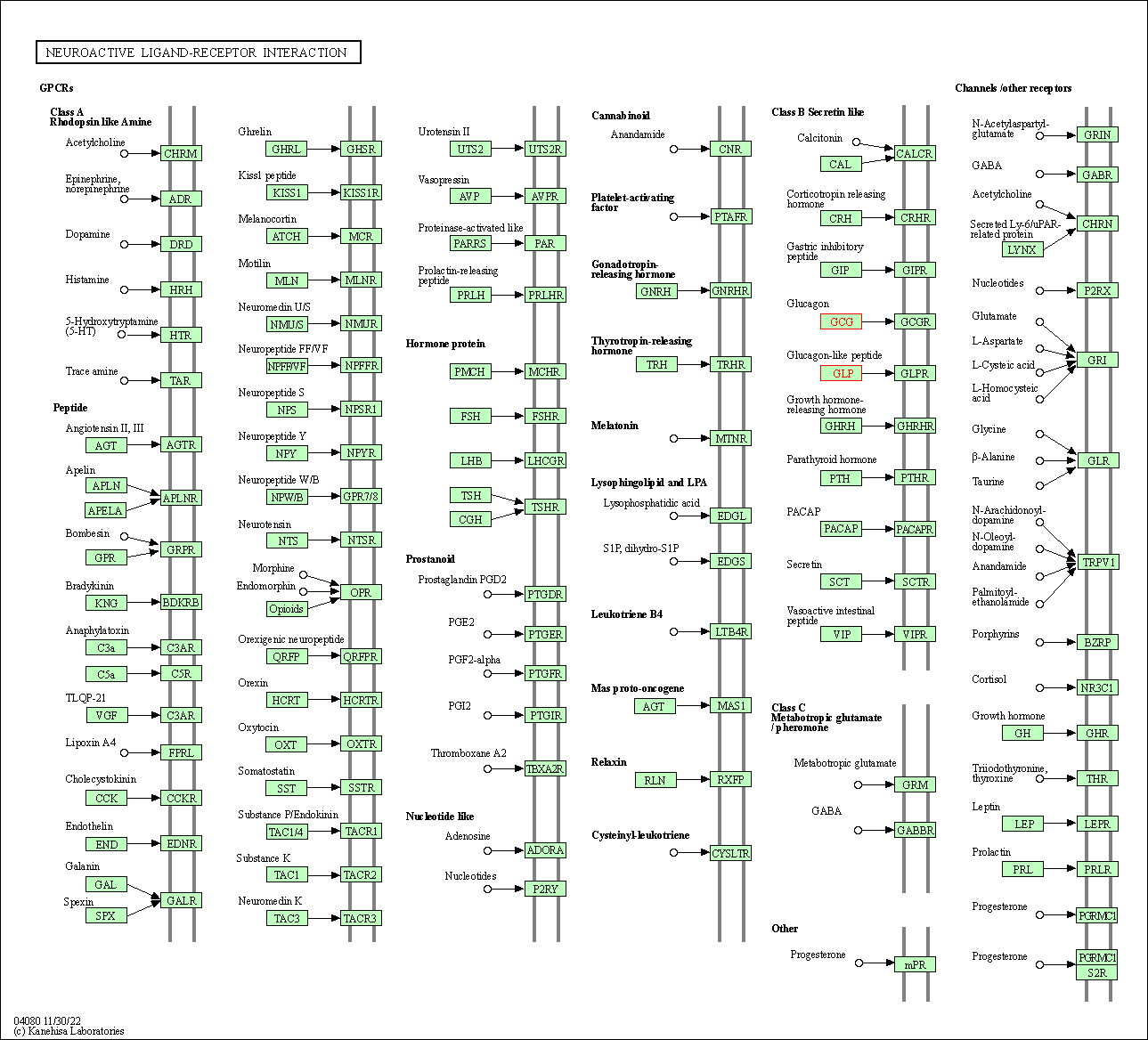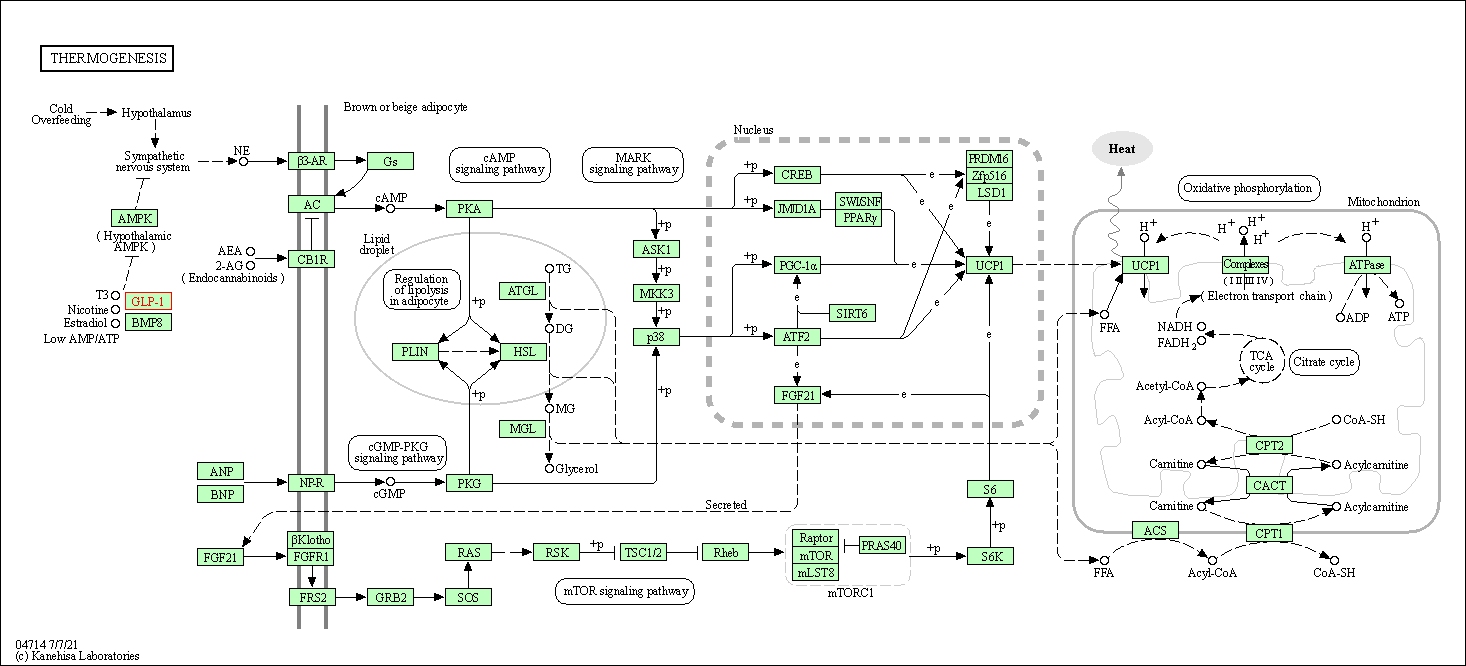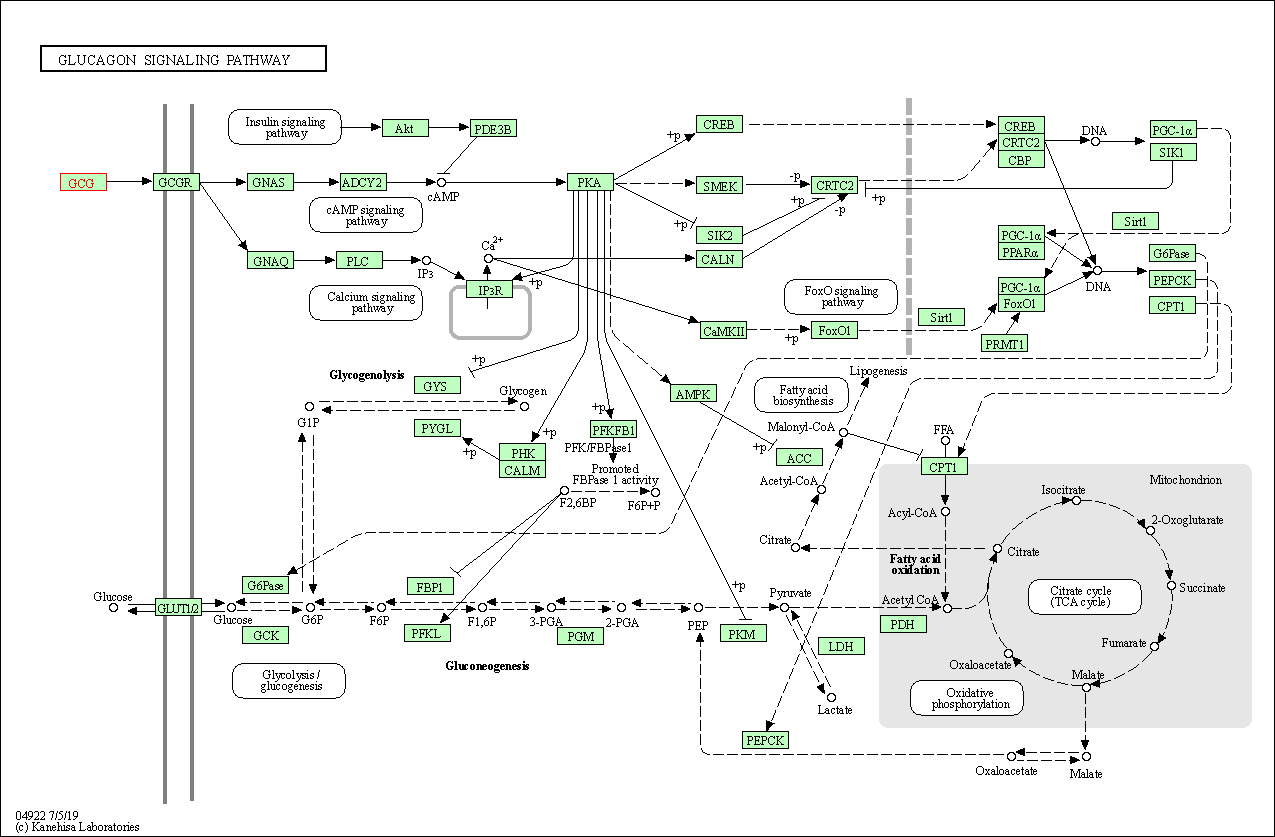Target Information
| Target General Information | Top | |||||
|---|---|---|---|---|---|---|
| Target ID |
T44919
|
|||||
| Target Name |
Glucagon (GCG)
|
|||||
| Synonyms |
GRPP; GLP2; GLP1; GLP-1
Click to Show/Hide
|
|||||
| Gene Name |
GCG
|
|||||
| Target Type |
Clinical trial target
|
[1] | ||||
| Disease | [+] 5 Target-related Diseases | + | ||||
| 1 | Obesity [ICD-11: 5B80-5B81] | |||||
| 2 | Parkinsonism [ICD-11: 8A00] | |||||
| 3 | Type 2 diabetes mellitus [ICD-11: 5A11] | |||||
| 4 | Acute diabete complication [ICD-11: 5A2Y] | |||||
| 5 | Diabetes mellitus [ICD-11: 5A10] | |||||
| Function |
Glucagon plays a key role in glucose metabolism and homeostasis. Regulates blood glucose by increasing gluconeogenesis and decreasing glycolysis. A counterregulatory hormone of insulin, raises plasma glucose levels in response to insulin-induced hypoglycemia. Plays an important role in initiating and maintaining hyperglycemic conditions in diabetes.
Click to Show/Hide
|
|||||
| BioChemical Class |
Glucagon
|
|||||
| UniProt ID | ||||||
| Sequence |
MKSIYFVAGLFVMLVQGSWQRSLQDTEEKSRSFSASQADPLSDPDQMNEDKRHSQGTFTS
DYSKYLDSRRAQDFVQWLMNTKRNRNNIAKRHDEFERHAEGTFTSDVSSYLEGQAAKEFI AWLVKGRGRRDFPEEVAIVEELGRRHADGSFSDEMNTILDNLAARDFINWLIQTKITDRK Click to Show/Hide
|
|||||
| 3D Structure | Click to Show 3D Structure of This Target | AlphaFold | ||||
| HIT2.0 ID | T02DEN | |||||
| Drugs and Modes of Action | Top | |||||
|---|---|---|---|---|---|---|
| Clinical Trial Drug(s) | [+] 7 Clinical Trial Drugs | + | ||||
| 1 | JNJ-64565111 | Drug Info | Phase 2 | Obesity | [2] | |
| 2 | MEDI0382 | Drug Info | Phase 2 | Type-2 diabetes | [3] | |
| 3 | MK-8521 | Drug Info | Phase 2 | Type-2 diabetes | [1], [4] | |
| 4 | PB-1023 | Drug Info | Phase 2 | Type-2 diabetes | [1], [5] | |
| 5 | PT320 | Drug Info | Phase 2 | Parkinson disease | [6] | |
| 6 | SAR425899 | Drug Info | Phase 1 | Diabetic complication | [7] | |
| 7 | ZP2929 | Drug Info | Phase 1 | Type-1 diabetes | [1] | |
| Mode of Action | [+] 2 Modes of Action | + | ||||
| Agonist | [+] 6 Agonist drugs | + | ||||
| 1 | JNJ-64565111 | Drug Info | [1] | |||
| 2 | MEDI0382 | Drug Info | [1] | |||
| 3 | PB-1023 | Drug Info | [1] | |||
| 4 | PT320 | Drug Info | [8] | |||
| 5 | SAR425899 | Drug Info | [1] | |||
| 6 | ZP2929 | Drug Info | [1] | |||
| Co-agonist | [+] 1 Co-agonist drugs | + | ||||
| 1 | MK-8521 | Drug Info | [1] | |||
| Cell-based Target Expression Variations | Top | |||||
|---|---|---|---|---|---|---|
| Cell-based Target Expression Variations | ||||||
| Drug Binding Sites of Target | Top | |||||
|---|---|---|---|---|---|---|
| Ligand Name: L-glutamic acid | Ligand Info | |||||
| Structure Description | Solution structure of lipidated glucagon analog in water | PDB:2M5P | ||||
| Method | Solution NMR | Resolution | N.A. | Mutation | Yes | [9] |
| PDB Sequence |
HQGTFTSDYS
11 KKLDRRAQDF22 VQWLMNT
|
|||||
|
|
||||||
| Click to View More Binding Site Information of This Target and Ligand Pair | ||||||
| Ligand Name: Alpha-Aminoisobutyric Acid | Ligand Info | |||||
| Structure Description | Semaglutide-bound Glucagon-Like Peptide-1 (GLP-1) Receptor in Complex with Gs protein | PDB:7KI0 | ||||
| Method | Electron microscopy | Resolution | 2.50 Å | Mutation | No | [10] |
| PDB Sequence |
HEGTFTSDVS
17 SYLEGQAAKE27 FIAWLVRGR
|
|||||
|
|
||||||
| Click to View More Binding Site Information of This Target and Ligand Pair | ||||||
| Click to View More Binding Site Information of This Target with Different Ligands | ||||||
| Different Human System Profiles of Target | Top |
|---|---|
|
Human Similarity Proteins
of target is determined by comparing the sequence similarity of all human proteins with the target based on BLAST. The similarity proteins for a target are defined as the proteins with E-value < 0.005 and outside the protein families of the target.
A target that has fewer human similarity proteins outside its family is commonly regarded to possess a greater capacity to avoid undesired interactions and thus increase the possibility of finding successful drugs
(Brief Bioinform, 21: 649-662, 2020).
Human Tissue Distribution
of target is determined from a proteomics study that quantified more than 12,000 genes across 32 normal human tissues. Tissue Specificity (TS) score was used to define the enrichment of target across tissues.
The distribution of targets among different tissues or organs need to be taken into consideration when assessing the target druggability, as it is generally accepted that the wider the target distribution, the greater the concern over potential adverse effects
(Nat Rev Drug Discov, 20: 64-81, 2021).
Human Pathway Affiliation
of target is determined by the life-essential pathways provided on KEGG database. The target-affiliated pathways were defined based on the following two criteria (a) the pathways of the studied target should be life-essential for both healthy individuals and patients, and (b) the studied target should occupy an upstream position in the pathways and therefore had the ability to regulate biological function.
Targets involved in a fewer pathways have greater likelihood to be successfully developed, while those associated with more human pathways increase the chance of undesirable interferences with other human processes
(Pharmacol Rev, 58: 259-279, 2006).
Biological Network Descriptors
of target is determined based on a human protein-protein interactions (PPI) network consisting of 9,309 proteins and 52,713 PPIs, which were with a high confidence score of ≥ 0.95 collected from STRING database.
The network properties of targets based on protein-protein interactions (PPIs) have been widely adopted for the assessment of target’s druggability. Proteins with high node degree tend to have a high impact on network function through multiple interactions, while proteins with high betweenness centrality are regarded to be central for communication in interaction networks and regulate the flow of signaling information
(Front Pharmacol, 9, 1245, 2018;
Curr Opin Struct Biol. 44:134-142, 2017).
Human Similarity Proteins
Human Tissue Distribution
Human Pathway Affiliation
Biological Network Descriptors
|
|
|
There is no similarity protein (E value < 0.005) for this target
|
|
Note:
If a protein has TS (tissue specficity) scores at least in one tissue >= 2.5, this protein is called tissue-enriched (including tissue-enriched-but-not-specific and tissue-specific). In the plots, the vertical lines are at thresholds 2.5 and 4.
|





| KEGG Pathway | Pathway ID | Affiliated Target | Pathway Map |
|---|---|---|---|
| cAMP signaling pathway | hsa04024 | Affiliated Target |

|
| Class: Environmental Information Processing => Signal transduction | Pathway Hierarchy | ||
| Neuroactive ligand-receptor interaction | hsa04080 | Affiliated Target |

|
| Class: Environmental Information Processing => Signaling molecules and interaction | Pathway Hierarchy | ||
| Thermogenesis | hsa04714 | Affiliated Target |

|
| Class: Organismal Systems => Environmental adaptation | Pathway Hierarchy | ||
| Insulin secretion | hsa04911 | Affiliated Target |

|
| Class: Organismal Systems => Endocrine system | Pathway Hierarchy | ||
| Glucagon signaling pathway | hsa04922 | Affiliated Target |

|
| Class: Organismal Systems => Endocrine system | Pathway Hierarchy | ||
| Degree | 15 | Degree centrality | 1.61E-03 | Betweenness centrality | 2.35E-03 |
|---|---|---|---|---|---|
| Closeness centrality | 2.18E-01 | Radiality | 1.38E+01 | Clustering coefficient | 4.76E-02 |
| Neighborhood connectivity | 1.04E+01 | Topological coefficient | 7.97E-02 | Eccentricity | 12 |
| Download | Click to Download the Full PPI Network of This Target | ||||
| Chemical Structure based Activity Landscape of Target | Top |
|---|---|
| Target Regulators | Top | |||||
|---|---|---|---|---|---|---|
| Target-interacting Proteins | ||||||
| Target Affiliated Biological Pathways | Top | |||||
|---|---|---|---|---|---|---|
| KEGG Pathway | [+] 5 KEGG Pathways | + | ||||
| 1 | cAMP signaling pathway | |||||
| 2 | Neuroactive ligand-receptor interaction | |||||
| 3 | Thermogenesis | |||||
| 4 | Insulin secretion | |||||
| 5 | Glucagon signaling pathway | |||||
| References | Top | |||||
|---|---|---|---|---|---|---|
| REF 1 | Clinical pipeline report, company report or official report of the Pharmaceutical Research and Manufacturers of America (PhRMA) | |||||
| REF 2 | ClinicalTrials.gov (NCT03486392) A Study to Evaluate the Safety and Efficacy of JNJ-64565111 in Non-diabetic Severely Obese Participants. U.S. National Institutes of Health. | |||||
| REF 3 | ClinicalTrials.gov (NCT03596177) A Study to Evaluate the Effect of MEDI0382 on Energy Balance in Overweight and Obese Participants With Type 2 Diabetes Mellitus. U.S. National Institutes of Health. | |||||
| REF 4 | ClinicalTrials.gov (NCT02492763) A Preliminary Study of the Efficacy and Safety of MK-8521 for Type 2 Diabetes (MK-8521-004). | |||||
| REF 5 | Clinical pipeline report, company report or official report of PhaseBio Pharmaceuticals. | |||||
| REF 6 | ClinicalTrials.gov (NCT04269642) Phase IIa Study to Evaluate the Efficacy and Safety of Subcutaneous SR-Exenatide (PT320) in Patients With Early Parkinson's Disease. U.S.National Institutes of Health. | |||||
| REF 7 | ClinicalTrials.gov (NCT02411825) Multiple Ascending Dose Study in Healthy Male Subjects. U.S. National Institutes of Health. | |||||
| REF 8 | Sustained Release GLP-1 Agonist PT320 Delays Disease Progression in a Mouse Model of Parkinson's Disease. ACS Pharmacol Transl Sci. 2021 Mar 16;4(2):858-869. | |||||
| REF 9 | Structural Changes Associated with Peptide Lipidation Broaden Biological Function | |||||
| REF 10 | Structure and dynamics of semaglutide- and taspoglutide-bound GLP-1R-Gs complexes. Cell Rep. 2021 Jul 13;36(2):109374. | |||||
If You Find Any Error in Data or Bug in Web Service, Please Kindly Report It to Dr. Zhou and Dr. Zhang.

